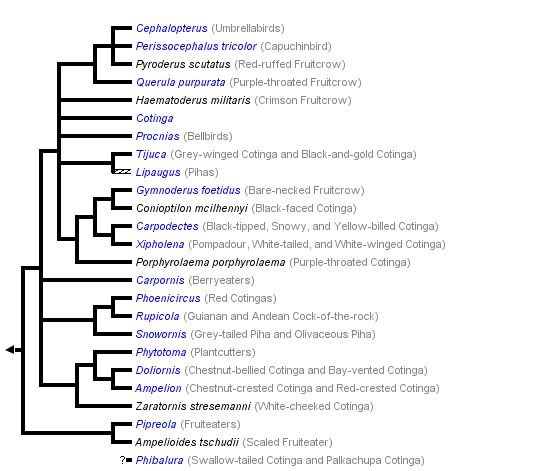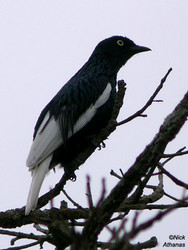Cotingidae
Cotingas
John Harshman


This tree diagram shows the relationships between several groups of organisms.
The root of the current tree connects the organisms featured in this tree to their containing group and the rest of the Tree of Life. The basal branching point in the tree represents the ancestor of the other groups in the tree. This ancestor diversified over time into several descendent subgroups, which are represented as internal nodes and terminal taxa to the right.

You can click on the root to travel down the Tree of Life all the way to the root of all Life, and you can click on the names of descendent subgroups to travel up the Tree of Life all the way to individual species.
For more information on ToL tree formatting, please see Interpreting the Tree or Classification. To learn more about phylogenetic trees, please visit our Phylogenetic Biology pages.
close boxDiscussion of Phylogenetic Relationships
Cotingidae was once home, in some classifications at least, to a number of taxa now assembled into a new family, Tityridae, as well as the enigmatic and endangered Calyptura cristata. It has now been pared back to a clearly monophyletic group. Phibalura has not been sampled in any modern analysis; though clearly a cotinga, its position is unclear; it has been suggested to be close to Ampelion.References
Gill, F. and M. Wright. 2006. Birds of the World: Recommended English Names. Princeton NJ: Princeton University Press.
Lanyon, S.M. 1985. Molecular perspective on higher-level relationships in the Tyrannoidea (Aves). Systematic Zoology 34:404–18.
Lanyon, S.M. and W.E. Lanyon. 1989. The systematic position of the plantcutters, Phytotoma. Auk 106:422–432.
Ohlson, J. I., R. O. Prum, and P. G. P. Ericson. 2007. A molecular phylogeny of the cotingas (Aves : Cotingidae). Molecular Phylogenetic and Evolution 42(1):25-37.
Prum, R. O., Rice, N. H., Mobley, J. A., and Dimmick, W. W. 2000. A preliminary phylogenetic hypothesis for the cotingas (Cotingidae) based on mitochondrial DNA. Auk 117: 236-241.
Snow, D.W. 1982. The Cotingas. Oxford University Press.
Snow, D.W. 2004 Family Cotingidae (Cotingas). Pages 32–108 in Handbook of the Birds of the World vol. 9. J. del Hoyo, A. Elliott and D.A. Christie, eds. BirdLife International and Lynx Editions, Cambridge, UK and Barcelona.
Tello, J. G., R. G. Moyle, D. J. Marchese, and J. Cracraft. 2009. Phylogeny and phylogenetic classification of the tyrant flycatchers, cotinga, manakins, and their allies (Aves: Tyrannides). Cladistics 25:1-39.
Title Illustrations

| Scientific Name | Xipholena lamellipennis |
|---|---|
| Location | Serra dos Carajás, Pará state, Brazil |
| Comments | It occurs widely in the eastern part of the Amazon basin, but there are few easily accessible places where it can be found. They are regularly found in Carajás, especially in hilly areas where you can get clear views of the canopy. |
| Specimen Condition | Live Specimen |
| Sex | Male |
| Copyright | © Nick Athanas |
| Scientific Name | Rupicola peruvianus |
|---|---|
| Location | Abra Patricia, Amazonas dept., Peru |
| Specimen Condition | Live Specimen |
| Sex | Male |
| Source | Andean Cock-of-the-rock (Rupicola peruviana) |
| Source Collection | Flickr |
| Image Use |
 This media file is licensed under the Creative Commons Attribution-NonCommercial License - Version 2.0. This media file is licensed under the Creative Commons Attribution-NonCommercial License - Version 2.0.
|
| Copyright | © 2009 David Cook Wildlife Photography |
| Scientific Name | Carpornis cucullata |
|---|---|
| Location | Rio De Janeiro, Brazil |
| Specimen Condition | Live Specimen |
| Source | Corocochó |
| Source Collection | Flickr |
| Copyright | © 2008 Joao Quental |
About This Page
Correspondence regarding this page should be directed to John Harshman at
Page copyright © 2009
 Page: Tree of Life
Cotingidae. Cotingas.
Authored by
John Harshman.
The TEXT of this page is licensed under the
Creative Commons Attribution-NonCommercial License - Version 3.0. Note that images and other media
featured on this page are each governed by their own license, and they may or may not be available
for reuse. Click on an image or a media link to access the media data window, which provides the
relevant licensing information. For the general terms and conditions of ToL material reuse and
redistribution, please see the Tree of Life Copyright
Policies.
Page: Tree of Life
Cotingidae. Cotingas.
Authored by
John Harshman.
The TEXT of this page is licensed under the
Creative Commons Attribution-NonCommercial License - Version 3.0. Note that images and other media
featured on this page are each governed by their own license, and they may or may not be available
for reuse. Click on an image or a media link to access the media data window, which provides the
relevant licensing information. For the general terms and conditions of ToL material reuse and
redistribution, please see the Tree of Life Copyright
Policies.
- First online 28 November 2009
- Content changed 28 November 2009
Citing this page:
Harshman, John. 2009. Cotingidae. Cotingas. Version 28 November 2009 (under construction). http://tolweb.org/Cotingidae/67999/2009.11.28 in The Tree of Life Web Project, http://tolweb.org/












 Go to quick links
Go to quick search
Go to navigation for this section of the ToL site
Go to detailed links for the ToL site
Go to quick links
Go to quick search
Go to navigation for this section of the ToL site
Go to detailed links for the ToL site